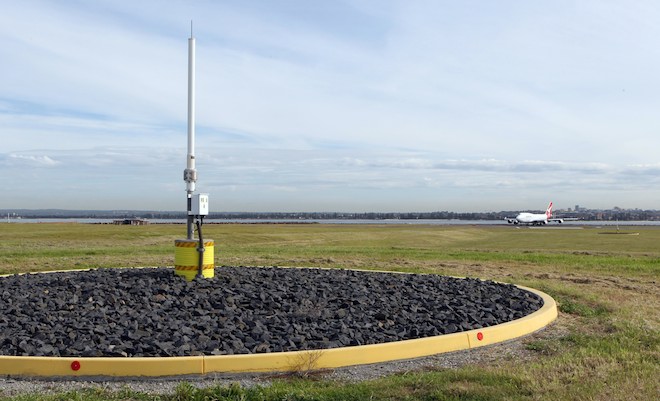
Sydney Airport’s Ground Based Augmentation System – GBAS – has been commissioned into service, clearing the way for operational use of the technology which ultimately promises GPS-augmented precision guidance approaches to CAT III mimima standards.
Sydney Airport’s GBAS system was launched on Wednesday by Deputy Prime Minister Warren Truss as well as Airservices acting CEO, Mark Rodwell, Honeywell Aerospace’s VP for Airlines Asia Pacific Brian Davis, Qantas chief financial officer Gareth Evans and Sydney Airport CEO Kerrie Mather, after it received CASA certification on May 29.
The ‘SmartPath’ GBAS system provides precision approaches by broadcasting error-corrected GPS positioning data to a suitably-equipped aircraft’s flight management system via a radio datalink from a ground-based transmitter. It is capable of providing up to 26 simultaneous instrument approaches within a 42km radius from the airport and promises to reduce maintenance and provide more efficient calibration than traditional instrument landing systems, Airservices says.
Qantas and Airservices had been trialling Sydney Airport’s Honeywell SLS-4000 GBAS since December 2012, and subsequently more than 750 approaches were flown by 737-800s and A380s. That followed on from an earlier prototype system installed at the airport which was in trial use between 2006 and 2010.
Compared to ILS GBAS requires only a single installation per airport (rather than at each runway end), is less expensive to maintain, and is not susceptible to noise signal interference. GBAS approaches can also be designed “to avoid terrain, shorten track miles, and reduce noise and emissions while improving traffic throughput”, according to Honeywell.
Currently GBAS, which has demonstrated accuracy of less than one metre in both the horizontal and vertical axis, is certified to CAT I minima levels. As well as Sydney Honeywell’s SmartPath system is also operational at Newark, Houston, Charleston and Moses Lake in the US and Bremen, Germany.
















Mike Monk
says:There is no mention of what happens when the GPS cannot receive more than 3 satellites or when the PDOP and HDOP fall to unusable levels.
Does the system still send correctional data or does it send an out-of-service flag to the a/c receivers?
Also, does the system on the a/c alert the crew for loss of performance and if so does it stop giving guidance information to the crew until acceptable performance is resumed?
Mike
Unodetantos
says:“As well as Sydney Honeywell’s SmartPath system is also operational at Newark, Houston, Charleston and Moses Lake in the US and Bremen, Germany.”
It would seem that Spain’s Malaga GBAS station, commissioned on 1st May 2014, is missing from this list.